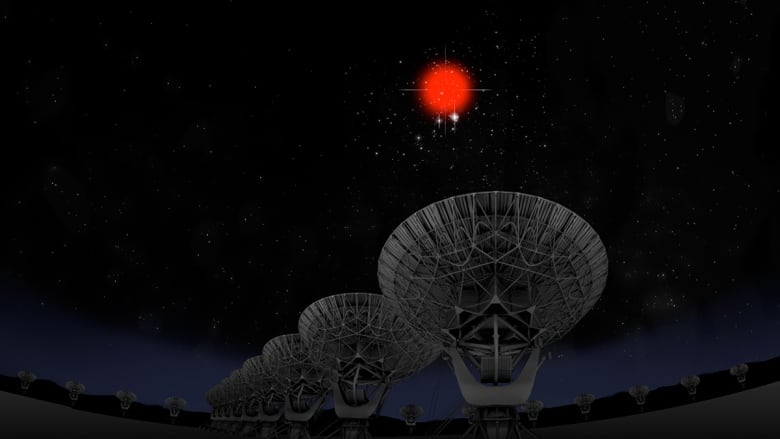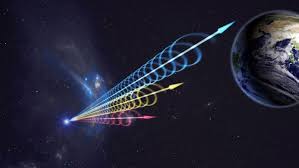Found in different galaxy than 1st signal, astronomers 1 step closer to finding out where these bursts thrive
Source: CBC News
They travel through space, and they’ve puzzled astronomers since they were first discovered just over decade ago. They’re called fast radio bursts, and thanks to a team of Canadian scientists, a new signal has been precisely located in a nearby galaxy. It’s a major step to figuring out where these enigmas come from in our universe.
The findings are in part due to the Canadian Hydrogen Intensity Mapping Experiment (CHIME) Fast Radio Burst collaboration, a team made up of more than 50 scientists across North America. The team collects data from a radio telescope stationed at the Dominion Radio Astrophysical Observatory south of Penticton, B.C.
FRBs are bright bursts of radio waves that come from far beyond Earth’s galaxy. Lasting less than a second, the phenomenon was first reported in 2007. Many have been spotted since, but only around a dozen have been shown to repeat — a quality crucial to spotting them again so researchers can find out more.
There are many theories of what they could be, but with such a small sample size, astronomers can’t rule much out just yet. They’ve only traced the origins of two repeating signals so far.

“They’re telling us something about an energetic arena we’ve had very little insight of to date,” said Paul Delaney, a professor in the physics and astronomy department at York University who was not involved in the study.
“It’s going to give us a window into new astrophysics, and that gives us a better understanding of the universe as a whole,” he said.
The team, co-led by the universities of British Columbia, Toronto and McGill, along with the National Research Council of Canada, has been working toward that goal since 2017.
The telescope’s ability to look at large portions of the sky at a time gives the team a better look at the random and elusive behaviour of FRBs, said the University of Toronto’s Mubdi Rahman, CHIME research associate and co-author of the study.
“Unlike most other telescopes, CHIME stays stable and doesn’t point at things. It lets the sky move,” he said.
After co-ordination with CHIME, the latest burst to be tracked, known as FRB 180916.j0158+65, was spotted and tracked by the European VLBI Network, eight telescopes spanning the globe.
The eight-metre Gemini North telescope in Hawaii was the crucial last piece to trace the FRB to a spiral galaxy 500 million light years away, according to results published in the Jan. 9 edition of Nature.
Since the discovery, scientists have found nine more repeating signals from space, according to a report released earlier this week. That means they could be localized, too, identifying the environments in space they come from, what causes them — and eventually, what these massive energy bursts are.

But CHIME can’t localize FRBs on its own. After seeing the signals repeat, it can narrow down the origins to certain parts of the sky. CHIME can then team up with more precise telescopes to match it with a galaxy. It’s set to get an extension in a few years that will enable it to localize data points on its own.
Right now, the telescope is predicted to detect between two and 50 FRBs per day, an event rate scientists consider very high. That’s putting CHIME, a Canadian led and funded project, at the forefront of FRB research.
CHIME was also behind the first repeater ever spotted, FRB 121102. It was traced to a different environment, a dwarf galaxy in 2017.
Both repeaters tracked so far have been found to originate from star-forming galaxies, an attribute that might be important for further research, said Deborah Good, a post-doctoral student at UBC and CHIME researcher.
“It’s hard to say. We always have to be really careful about generalizing from a really small number like this,” she said. “But it also means that every data point we get is super important.”
Source: CBC News

































Leave a Comment
You must be logged in to post a comment.